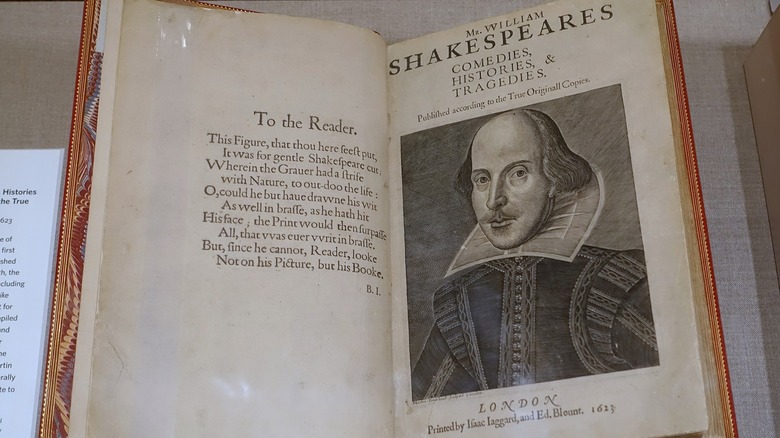What Happened To Shakespeare's 1655 King Lear Book From Antiques Roadshow?
Plenty of folks have loads of junk hanging around the basement, attic, garage, packed into closets, crammed into glove compartments, shoved into the back of cupboards, you name it. Some stuff might be personally meaningful no matter how forgotten, like an old handwritten rice pudding recipe that grandma scratched out when she was young. Other things might have monetary value, like a mint-condition baseball card. And yet other things might have greater cultural value beyond one person, one family, and however many generations of people kept such items safe.
Enter the charming "Antiques Roadshow," a series that's unearthed hidden treasures like an antique pocket watch from Swiss timepiece maker Patek Philippe, 18th-century Chinese jadeware, ancestral Navajo blankets, masterwork paintings, and more. When the "Roadshow" crew stopped in the tiny, 6,000-person town of Shelburne, Vermont in July 2022, manuscript appraiser Devon Eastland took a look at a "rather skinny, ratty-looking volume" that seller Mike (no last name) pulled from a box, as Eastland herself writes on PBS. Rare Book Hub says that Mike's grandfather had collected books, and passed his collection along to his family.
The book, it turns out, was nothing less than a 1655 edition of William Shakespeare's monumental play "King Lear," printed in quarto format — paper folded once, then again into a small size. Per Rare Book Hub, U.K. auctioneers Sotheby's sold it in 1946 for £28, and Eastland appraised it at $10,000 to $15,000. When the bidding finally stopped, however, the quarto sold for $57,500.
Third quarto edition, female printer
William Shakespeare wrote and collaborated on about 38 plays during his life. "Henry VI, Part II" was his first play to be performed from 1590 to 1591, while all of his big, well-known tragedies — "Hamlet," "Macbeth," "Othello," and "King Lear" — came later. The Royal Shakespeare Company tells us that "King Lear" was probably written sometime after 1603 and first performed in 1608. Shakespeare died in 1616, and by 1623 the first collected volume of his works — the First Folio — was published (pictured above). The edition of "King Lear" from "Antiques Roadshow" came 32 years later in 1655. It was a smaller, cheaper, paperback edition called a quarto — like a folio-sized book, but folded again into quarter-sizes pages. And as appraiser Devon Eastland writes on PBS, it was in pretty bad shape.
Eastland says that the quarto's seller, Mike, had just kept "King Lear" on a shelf with some other 17th-century books. The book's binding was failing, its cover page was frayed, and it felt like it was going to fall apart when handled. And yet, even taking such a poor condition into account, Eastland valued "King Lear" at $10,000 to $15,000. Not only are quarto editions less common, but the publisher — Jane Bell — was a woman, which was rare for the time. Besides, the book could be restored. Eastland herself restored it, which helped it sell for a high price at auction.
[Featured image by Daderot via Wikimedia Commons | Cropped and scaled | CC0 1.0 DEED]
New binding, high sale price
While we don't know what happened to the quarto of "King Lear" on "Antiques Roadshow" after it sold at auction, or who bought it, we know that the book provoked some frenzied bidding. On PBS, appraiser Devon Eastland says that bidding quickly shot past her original valuation all the way to $20,000, $30,000, and higher. Thanks to two competing phone bidders the final sale price hit $57,500, per Rare Book Hub, $46,000 of which went to the seller, Mike.
We can see the quarto's original auction listing on Swann Auction Galleries — lot 124, sale number 2,617. The page says that there are 17 copies of the exact edition of "King Lear" in question kept in U.K. and U.S. institutions. The publisher, Jane Bell, published 25 books from 1649 to 1661, and she might have done so illegally. The quarto itself is a trim 88 pages long, with some "browning" along the pages and a really pretty, new cover that Eastland crafted — no doubt the cover helped attract bidders.
On PBS, Eastland says that when the quarto hit "Antiques Roadshow" it didn't have its original binding, anyway. It's possible that the book might have been extracted from some larger volume, or was never bound correctly to begin with and got passed around here and there before making its way to Sotheby's in London in 1946 and then across the Atlantic Ocean. That's quite a journey for a book published over 370 years ago.


